Ty schody znám - bylo to úžasný se dvěma našima dětma a ještě s kámošem kterej měl dva prcky do školky - ale zvládlo se to ten pohled ze střílen je k nezaplacení -a hlavně všude přítomné kartičky - Měli sme se bránit !!!
Fortress Dobrošov
Categories: Wars
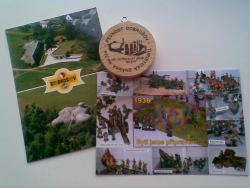 One of the stops on our four-day excursion was the Dobrošov Fortress. It is a dismantled artillery fortress, part of the Czechoslovak border fortifications from 1935-1938. The importance of Dobrošov Fortress was negligible. It would take almost one more year to complete at least in terms of construction. After the Munich Agreement, the fortification was handed over to Germany, but Náchod did not belong to the Sudetenland and our army was left with a few almost armed objects. Of course, the army knew that it was pointless to keep several objects and so began to sell off their equipment (not weapons). As for Dobrosov. The construction company included all the working shafts, and a makeshift gate was built instead of an entrance building.
One of the stops on our four-day excursion was the Dobrošov Fortress. It is a dismantled artillery fortress, part of the Czechoslovak border fortifications from 1935-1938. The importance of Dobrošov Fortress was negligible. It would take almost one more year to complete at least in terms of construction. After the Munich Agreement, the fortification was handed over to Germany, but Náchod did not belong to the Sudetenland and our army was left with a few almost armed objects. Of course, the army knew that it was pointless to keep several objects and so began to sell off their equipment (not weapons). As for Dobrosov. The construction company included all the working shafts, and a makeshift gate was built instead of an entrance building.
The fortress is located less than 3 km from the village of the same name, Dobrosov, in the Hradec Králové region, in the Náchod region near the border with Poland. In the underground you will be welcomed by a pleasant temperature of 6 °C, visitors have a limited number of opportunities to borrow warm clothing in the ticket office of the fortress. The tour is a bit physically demanding, due to the number of stairs that lead to the underground.
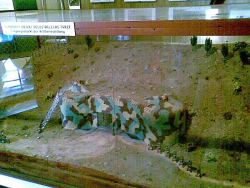 The tour started in the exhibition hall, which houses the largest collection of figures in Europe that represent the Czechoslovak Army of 1938, created by model maker Lubor Šušlík. The exhibition is constantly being expanded and currently there are about 1250 figures on display. There was also an introductory lecture, especially about the history of the fortress. Maps, diagrams and models of fortification objects are also displayed in the hall.
The tour started in the exhibition hall, which houses the largest collection of figures in Europe that represent the Czechoslovak Army of 1938, created by model maker Lubor Šušlík. The exhibition is constantly being expanded and currently there are about 1250 figures on display. There was also an introductory lecture, especially about the history of the fortress. Maps, diagrams and models of fortification objects are also displayed in the hall.
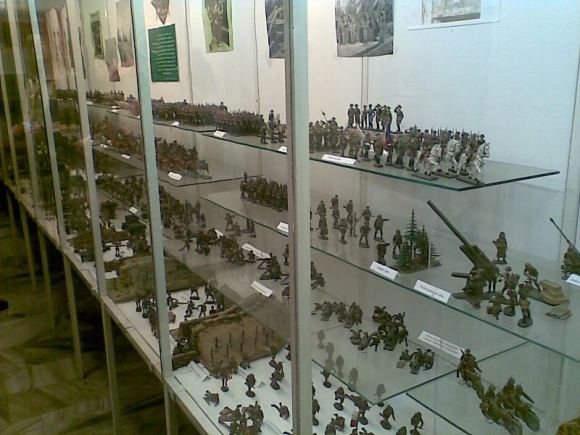
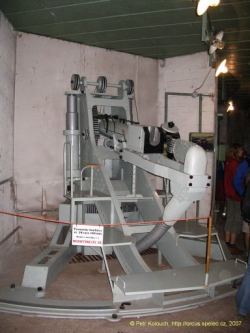
The tour then continues with the entrance to the Zelený "log cabin" (47x16 m in size, with a wall and ceiling thickness of 3.5 m and a cubic capacity of 5,520 m3 of concrete). The visitor must pass through a protective trench. Interpretation continues on the upper floor, where there are mock-ups of howitzers vz.38 of 10 cm calibre, which resemble the main armament of the hut. There are also photo panels documenting the events in the Czechoslovakia before the Munich war. On the lower (rear) floor there are rooms intended for the placement of the filteringfiltration equipment, sanitary facilities, a waste pit for cartridges and a quarters.
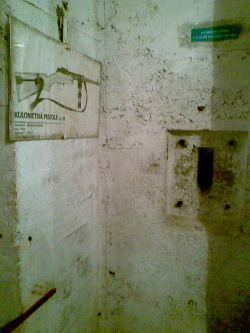
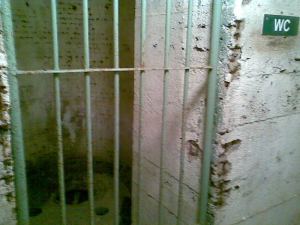
From both floors you could see into the elevator shafts. Looking down, we were breathless. Two fast lifts were to connect the underground ammunition stores with the combat floor of the artillery barracks.
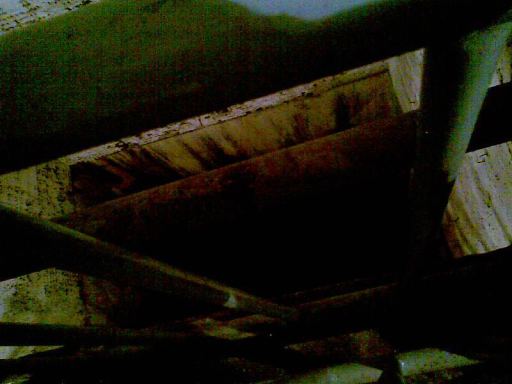
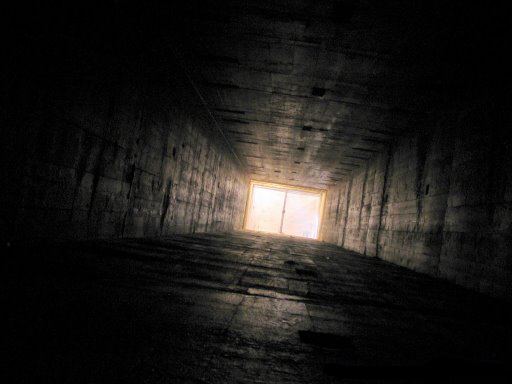
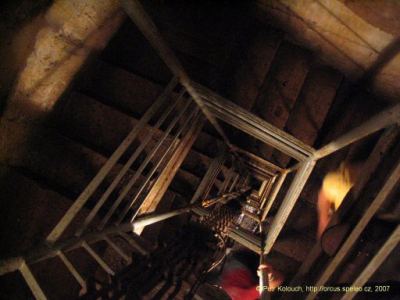
A square staircase descends to the underground (about 150 steps).
Underground there are ammunition warehouses that have been completed and a part of the gallery is being walked through. The barracks are the most interesting. The tour of the underground ends under the infantry cabin Mostek. The visitor will climb about 250 steps to the rear floor of this log cabin, which is preserved in relatively good condition, although it has been devastated. The battle floor in particular is damaged. In a small exhibition one can see fragments of projectiles, which are directly related to the devastation of the building. This is a Röchling missile, one of the so-called secret weapons of the Third Reich. Such a projectile can penetrate several tens of metres of overburden and hit the fortress barracks deep underground or directly penetrate 3.5 metres of Belgian fortress reinforced concrete. Today it is certain that testing of Röchling shells also occurred at Dobrosov. Object N - S 72 Mostek was fired from a distance of about 200 meters by direct fire (the first variants of Röchlings were developed for indirect fire).
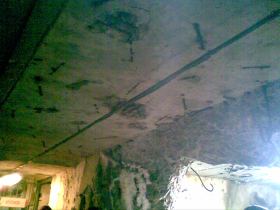
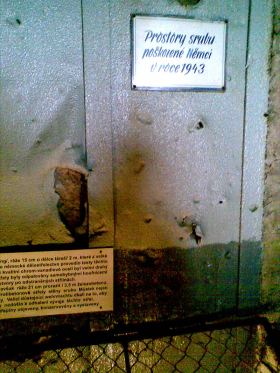
Underground- 1750 m of connecting corridors ( at a depth of 20 - 39 m below the ground surface ) and about 750 m of underground halls ( future barracks, warehouses, technical facilities, .Approximately half of these areas have been concreted Out of the total contract amount of 42.800.000,- CZK, approximately 19.000.000,- CZK were billed after the suspension of work.
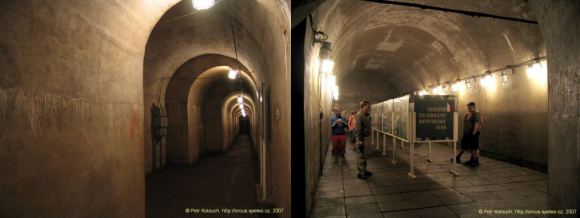
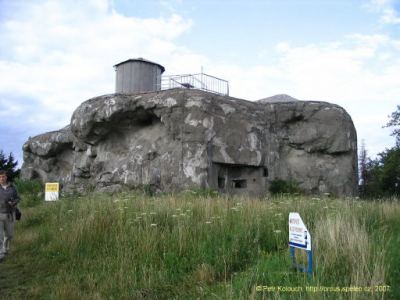
The staircase ends on the ceiling platform of the Mostek log cabin and in good weather the visitor enjoys a beautiful view for a radius of up to 80 km. The third of the completed buildings, the N-S 73 Crane Cabin, is not normally accessible, but is usually open on public holidays (see opening hours). It is 600 m away from the Mostek cabin and can be reached by marked trails. The outer walls of the building bear traces of practice firing by German infantry. The interior of the entrance to the log cabin is entered through an emergency opening. The third of the completed buildings, the N-S 73 Crane Cabin, is not normally accessible, but is usually open on public holidays (see opening hours). It is 600 m away from the Mostek cabin and can be reached by following the marked trails. The outer walls of the building bear traces of practice firing by German infantry.
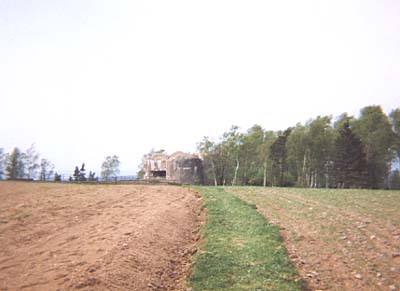
The Crane Cabin was manned in September 1938 by a unit of 25 men. This was, of course, small compared to the planned combat value. The fully completed fortress was to have an impressive firepower of eight Y guns (10 cm howitzer vz. 38, twin turrets, two three-gun batteries in the artillery columns), two 12 cm mortars (in the mortar turret), six L1 weapons (4 cm anti-tank gun vz. 36, coupled with a heavy machine gun vz. 37), four M guns (twin heavy machine guns vz. 37), two of them under the concrete and two in the dome, eighteen N guns (LK vz. 26 - seven of them under the concrete, eleven in the armoured bells). The garrison at full wartime strength was to number 571 men, and the additional strength was one and a half companies of reinforcement infantry intended for active combat on the surface of the fortress or in its vicinity.
Visitors can also take the nature trail, which starts at the artillery cabin Zelený, is signposted and has two routes. Unfortunately, we did not take this one because we were pressed for time.
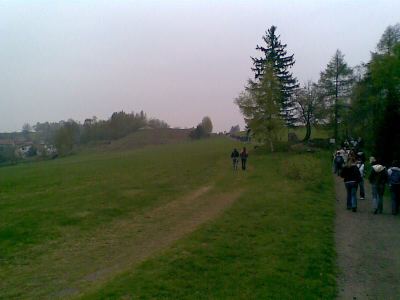
Otherwise, we were traveling with about 120 people, which was sometimes quite impractical, because it created a nice crowd =). The biggest experience was climbing the stairs, when several participants of the excursion suffered from dizziness, so from the beginningOur ascent started briskly, but after a few dozen stairs a stair jam formed. When we finally climbed, or rather crawled up, many of us felt like we were about to spit out our lungs. At this point, it was mostly the non-smokers who had to go up=)) who weren't so red and weren't shouting all over the staircase. Despite the bitter cold, which some individuals underestimated (myself included), this tour was an unforgettable experience.
You can search for artifacts from this era with our metal detectors.
Photo: viky, Petr Kolouch
Text: viky, internet
The article is included in categories:
Post
Díky za hezký článek o Dobrošovské pevnosti. Z prohlídky mám také nezapomenutelné zážitky.Pevnost jsme navštívili v parném létě,teplota ve stínu nahoře byla asi plus 35 stupňů, dole bylo asi kolem nuly.Naše oblečení bylo adekvátní venkovní teplotě a měl mi varovat jiný oděvní styl našeho průvodce,kterému nechyběla ani pořádná vojenská beranice.Prohlídka trvala asi hodinu a tak nás už ke konci nikoho moc nezajímala a tak když jsme došli k těm schodům a průvodce nás propustil,oněch asi 170 schodů jsem stíhal asi za minutu a vylétl ven do žhavého prostředí jak raketa.Od té doby jsem tam pak byl několikrát,ale vždy už dobře navlečen,takže jsem si prohlídku mohl patřičně vychutnat. Můj dojem je stejný,jako pisatelů lístečků,ano,bránit jsme se měli.Bohužel většinou jsou to politická rozhodnutí,která prohrávají bitvy...




